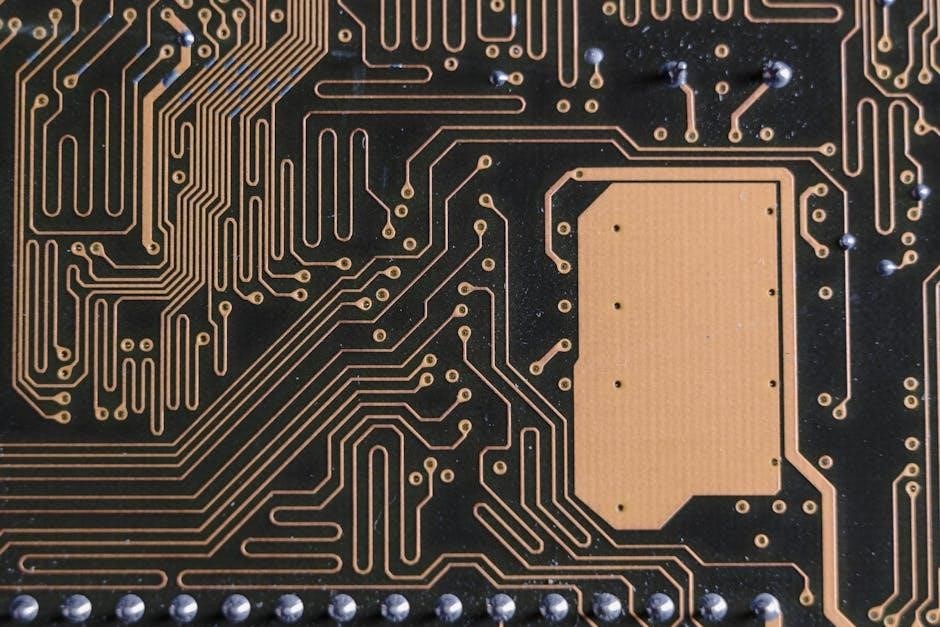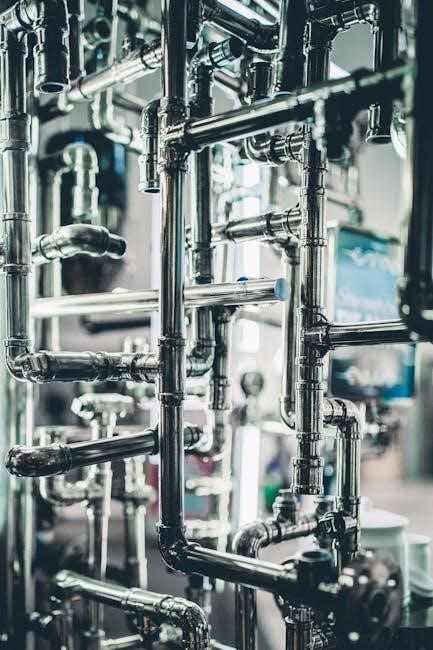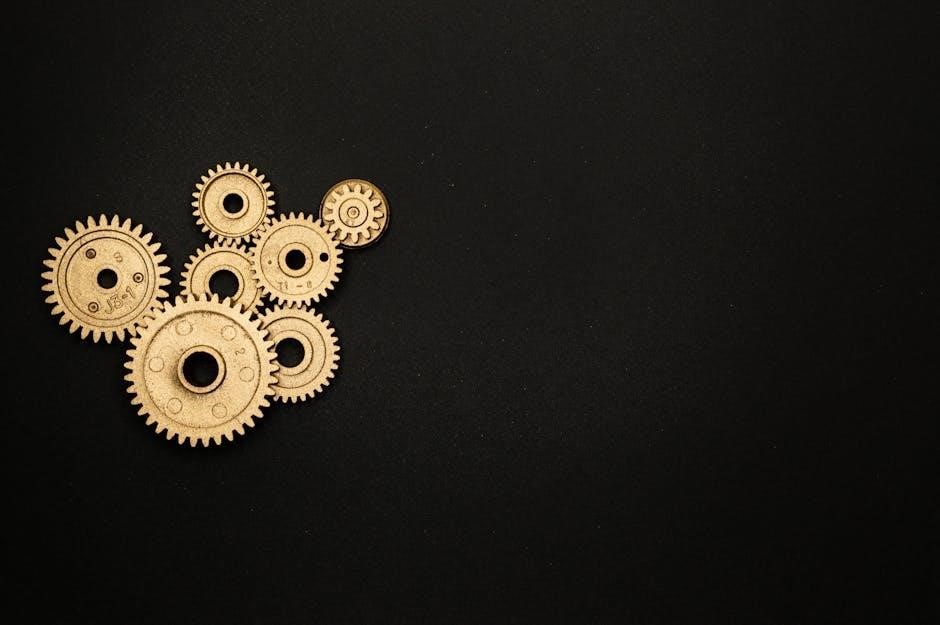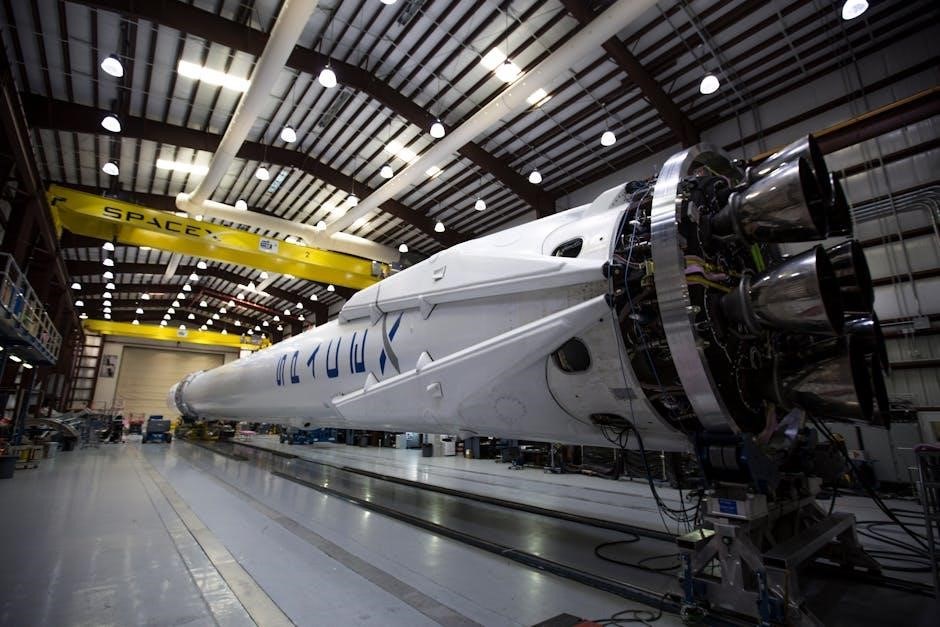The skeletal system, comprising 206 bones, 32 teeth, cartilage, and ligaments, forms the body’s framework, providing support, protection, and facilitating movement. It also stores minerals and enables blood cell production.
1.1 Definition and Overview
The skeletal system is the framework of the human body, consisting of bones, cartilage, ligaments, and tendons. It provides structural support, protects vital organs, and facilitates movement. Comprising 206 bones and 32 teeth, it is divided into the axial and appendicular skeletons. This system also stores minerals like calcium and phosphorus and produces blood cells in the bone marrow. Its functions are essential for maintaining posture, enabling mobility, and safeguarding internal organs, making it a critical component of human anatomy.
1.2 Importance of the Skeletal System in the Human Body
The skeletal system is vital for maintaining the body’s structure, enabling movement, and protecting internal organs. It serves as a framework for muscle attachment, facilitating mobility and posture. Additionally, it shelters critical organs like the brain, heart, and lungs. The skeletal system also stores essential minerals such as calcium and phosphorus, supporting overall bodily functions. Its role in blood cell production further underscores its importance in maintaining health and vitality, making it a foundational system for human survival and functionality.
1.3 Components of the Skeletal System
The skeletal system consists of bones, cartilage, ligaments, and tendons. Bones provide structural support and protection, while cartilage acts as a cushion in joints. Ligaments connect bones to each other, offering stability, and tendons link muscles to bones, enabling movement. This system also includes bone tissue, which is categorized into compact and spongy bone, each serving distinct functions. Together, these components form a dynamic framework essential for movement, organ protection, and overall bodily integrity.

Functions of the Skeletal System
2.1 Support and Structure
The skeletal system provides a framework, anchoring muscles and maintaining posture. Bones work together to support the body, enabling movement and stability through their interconnected structure.
The skeletal system acts as the body’s internal framework, providing structural support and maintaining posture. Bones serve as anchors for muscles, enabling movement and stability. The axial and appendicular skeletons divide this framework, with the axial skeleton supporting the upper body and the appendicular skeleton forming the limbs. This system ensures the body’s shape and alignment, allowing for efficient movement and distribution of weight. It also protects vital organs by forming a sturdy, interconnected structure.
2.2 Protection of Internal Organs
The skeletal system protects vital organs by forming enclosures around them. The skull safeguards the brain, while the ribcage shields the heart, lungs, and liver. The vertebrae encase the spinal cord, preventing damage. Bones act as a protective barrier, absorbing external impacts and ensuring internal organs remain safe. This defensive function is crucial for maintaining bodily functions and overall health, allowing organs to operate without disruption from external forces. The skeletal system thus plays a vital role in preserving the body’s integrity.
2.3 Facilitation of Movement
The skeletal system facilitates movement by acting as a framework for muscle attachment. Bones serve as levers, while muscles generate force through contraction. Tendons connect muscles to bones, enabling precise movement. Joints, where bones meet, allow for flexibility and a range of motion, from hinge movements in elbows to rotational movements in shoulders. This integration of bones, joints, and muscles enables voluntary actions like walking and involuntary movements like breathing, making the skeletal system essential for mobility and bodily functions. Its structure ensures efficient mechanical advantage for various activities.
2.4 Blood Cell Production
The skeletal system plays a vital role in blood cell production through red marrow found in spongy bone. Red marrow produces red blood cells, white blood cells, and platelets. This process is essential for oxygen transport, immune defense, and blood clotting. In adults, red marrow is primarily located in flat and irregular bones, such as the pelvis, vertebrae, and ribs. This function highlights the skeletal system’s critical role in hematopoiesis, maintaining the body’s cellular balance and overall health. Bone marrow is indispensable for replenishing blood cells throughout life.
2.5 Mineral Storage
The skeletal system serves as a reservoir for essential minerals like calcium and phosphorus, storing them in bone tissue. Bones act as the body’s mineral bank, releasing these elements into the bloodstream when needed. This function ensures proper nerve and muscle function, as well as supports the formation of teeth and bones. The dynamic remodeling of bone tissue allows for the continuous exchange of minerals, maintaining overall bodily balance and preventing deficiencies. This storage system is crucial for sustaining life and preventing conditions like osteoporosis.

Structure of Bones
Bones are composed of compact and spongy bone tissue, with compact bone providing strength and spongy bone being lighter and containing red marrow for blood cell production.
3.1 Composition of Bone Tissue
Bone tissue consists of a hardened, calcified matrix of collagen fibers and minerals like calcium and phosphorus. This matrix is interspersed with living cells, including osteoblasts, osteocytes, and osteoclasts. Compact bone is dense and forms the outer layer, while spongy bone is porous and found inside bones, containing red marrow that produces blood cells. This composition provides strength, flexibility, and support, enabling bones to protect organs, facilitate movement, and store essential minerals for the body’s functioning.
3.2 Compact Bone vs. Spongy Bone
Compact bone is dense and forms the outer layer of bones, providing strength and protection. It consists of tightly packed osteons, or Haversian systems, which contain blood vessels and nerves. Spongy bone, in contrast, is porous and found inside bones, with a honeycomb structure filled with red marrow that produces blood cells. Compact bone offers durability, while spongy bone is lighter and aids in shock absorption, together creating a balanced skeletal structure optimized for support and functionality.
3.3 Parts of a Long Bone
A long bone consists of a shaft (diaphysis), two ends (epiphyses), and a region between the shaft and end (metaphysis). The epiphyses are covered with articular cartilage for smooth joint movement. The diaphysis is surrounded by a periosteum, a protective membrane. The medullary cavity, running through the shaft, contains bone marrow. Compact bone forms the diaphysis, while spongy bone is found in the metaphysis and epiphyses, optimizing strength and reducing weight for efficient mobility and support.

Classification of Bones
Bones are classified based on shape (long, short, flat, irregular), structure (compact or spongy bone), and development (endochondral or intramembranous ossification), ensuring diverse functional roles in the body.
4.1 Bones Classified by Shape
Bones are categorized by shape into four types: long, short, flat, and irregular. Long bones, like the femur and humerus, have greater length than width, enabling leverage for movement. Short bones, such as those in the wrist and ankle, are cube-like and provide stability. Flat bones, including the skull and sternum, offer protection and broad surfaces for muscle attachment. Irregular bones, such as vertebrae and pelvic bones, have unique shapes for specific functions, ensuring structural and functional diversity in the skeleton.
4.2 Bones Classified by Structure
Bones are structurally categorized into three types: compact, spongy, and cartilage. Compact bone is dense and provides strength, forming the outer layer of bones. Spongy bone is lighter, with a porous texture, found in bone ends and containing red marrow for blood cell production. Cartilage, though not bone, is part of the skeletal system, offering cushioning and facilitating smooth joint movement. This classification highlights the functional diversity of bone tissue in supporting the body’s structure and physiology.
4.3 Bones Classified by Development
Bones are classified by their developmental origin into intramembranous and endochondral bones. Intramembranous bones develop directly from mesenchymal cells in membranes, forming flat bones like the skull. Endochondral bones develop from cartilage templates, forming long bones such as the femur and humerus. Additionally, sesamoid bones, like the patella, develop within tendons. This classification highlights the distinct processes by which bones form and mature, shaping their structure and function in the skeletal system.
The Axial Skeleton
The axial skeleton consists of 80 bones, forming the skull, vertebral column, ribs, and sternum. It provides central support and protects vital organs like the brain and heart.
5.1 Bones of the Skull
The skull is composed of 22 bones, divided into the cranial vault and facial bones. The cranial vault protects the brain, while the facial bones form structures like the jaw and orbits. The frontal, occipital, and parietal bones form the cranial vault, providing a protective casing for the brain. Facial bones include the mandible, maxillae, and zygomatic bones, contributing to facial structure and functions like chewing and breathing. Together, they form a complex framework essential for sensory and motor functions.
The fusion of cranial bones during development ensures a rigid yet lightweight structure. Proper alignment and formation of these bones are crucial for both aesthetic and functional reasons. Any abnormalities in the skull bones can lead to various health issues, emphasizing their importance in overall bodily functions. The intricate design of the skull exemplifies evolutionary adaptations for protection and functionality.
5.2 Vertebrae and the Spinal Column
The spinal column, or vertebral column, consists of 33 vertebrae divided into five regions: cervical, thoracic, lumbar, sacrum, and coccyx. These vertebrae provide structural support, protect the spinal cord, and facilitate flexible movement. The cervical vertebrae support the head, while the lumbar vertebrae bear the body’s weight. The sacrum and coccyx form the base of the spine. Proper alignment of the vertebrae is crucial for nerve function and mobility. Misalignment can lead to various health issues, emphasizing the spinal column’s vital role in overall bodily functions. The spinal column’s design allows for both strength and flexibility, enabling a wide range of movements while safeguarding the central nervous system.
5.3 Ribcage and Sternum
The ribcage, formed by 12 pairs of ribs and the sternum, protects vital organs like the heart, lungs, and liver. The sternum, or breastbone, acts as the central anchor for the ribs. True ribs directly attach to the sternum, while false ribs connect via cartilage. The ribcage’s structure allows for chest expansion during breathing. Its flexibility and strength provide optimal protection while enabling respiratory and bodily movements. This complex arrangement ensures the ribcage functions efficiently as both a protective and dynamic component of the axial skeleton.

The Appendicular Skeleton
The appendicular skeleton includes the upper and lower limbs, pelvic and shoulder girdles, totaling 126 bones; It facilitates movement, supports the body, and provides attachment points for muscles.
6.1 Upper Limb Bones
The upper limb bones include the humerus, radius, ulna, carpals, metacarpals, and phalanges. These bones form the shoulder, elbow, wrist, and finger joints, enabling a wide range of movements. The humerus is the longest bone in the upper limb, while the phalanges are the smallest, allowing precise actions like gripping and writing. Together, these bones provide structural support and facilitate mobility, making them essential for daily activities and overall bodily function.
6.2 Lower Limb Bones
The lower limb bones include the femur, patella, tibia, fibula, tarsals, metatarsals, and phalanges. These bones form the hip, knee, and ankle joints, enabling activities like walking and running. The femur, the longest bone, connects to the pelvis, while the phalanges form the toes. Together, they provide structural support, facilitate movement, and bear the body’s weight, ensuring mobility and balance. This system is crucial for locomotion and maintaining upright posture, making it essential for daily functioning and overall physical stability.
6.3 Pelvic and Shoulder Girdles
The pelvic girdle, or os coxae, consists of the ilium, ischium, and pubis bones, forming a basin that connects the lower limbs to the axial skeleton. It supports the spine and facilitates hip movement. The shoulder girdle, or pectoral girdle, includes the scapula and clavicle, enabling arm mobility by linking the upper limbs to the axial skeleton. Together, these girdles provide stability, flexibility, and attachment points for muscles, crucial for movement and weight distribution.
Joints and Their Types
Joints are points where two or more bones meet, allowing movement and providing structural support. They are classified as synovial, cartilaginous, or fibrous, enabling various degrees of mobility.
7.1 Definition and Classification of Joints
Joints are connections between bones that allow movement and provide structural support. They are classified into three main types: synovial joints, which allow significant movement; cartilaginous joints, connected by cartilage; and fibrous joints, immovable or slightly movable, connected by dense connective tissue; This classification is based on the presence of a joint cavity and the type of connective tissue involved, enabling various degrees of flexibility and stability in the skeletal system.
7.2 Types of Joints Based on Movement
Joints are classified based on their ability to allow movement. Synovial joints, like hinge, ball-and-socket, pivot, plane, and saddle joints, permit significant movement. Cartilaginous joints, such as symphyses and synchondroses, allow limited movement due to cartilage connections. Fibrous joints, like sutures and gomphoses, are immovable or slightly movable, offering stability. This classification highlights the range of mobility within the skeletal system, from high flexibility to rigid stability, ensuring optimal functionality in different anatomical locations.
7.3 Importance of Joints in Mobility
Joints are essential for enabling movement, allowing bones to articulate and function together seamlessly. They provide structural support while facilitating flexibility, enabling actions like walking, running, and reaching. By connecting bones and muscles, joints transfer forces, making movement efficient. Different joint types cater to various movement needs, ensuring the body maintains posture and performs daily activities. Ultimately, joints are vital for mobility, enabling an active lifestyle and overall skeletal system functionality.
Bone Fractures and Healing
Bone fractures involve breaks in bone continuity, classified as transverse or oblique. Healing is a natural repair process, restoring bone strength and function over time.
8.1 Types of Fractures
Fractures are classified into two main categories: complete and incomplete. Complete fractures involve a full break across the bone, while incomplete fractures leave the bone partially intact. Transverse fractures occur straight across the bone, while oblique fractures are diagonal. Spiral fractures twist around the bone’s length, and comminuted fractures result in multiple bone fragments. Each type requires specific treatment approaches to ensure proper healing and restore function. Accurate diagnosis is crucial for effective management.
8.2 Bone Healing Process
The bone healing process involves four stages: inflammation, soft callus formation, hard callus formation, and remodeling. Initially, inflammation occurs, clearing debris and initiating repair; Next, a soft callus of cartilage and collagen forms, stabilizing the fracture. This is replaced by a hard callus of woven bone, restoring structural integrity. Finally, remodeling shapes the bone to its original form, restoring strength and function. Proper immobilization, nutrition, and blood supply are critical for effective healing.
8.3 Factors Affecting Bone Healing
Several factors influence bone healing, including nutrition, blood supply, and immobilization. Adequate intake of calcium and vitamin D supports bone repair, while smoking and diabetes can impede healing. Proper immobilization prevents movement at the fracture site, promoting effective repair. Age also plays a role, with younger individuals healing faster due to higher bone remodeling rates. Overall health and the presence of infections can further impact the efficiency and speed of the bone healing process.

Skeletal System Disorders
Skeletal disorders like osteoporosis, arthritis, and fractures affect bone health, often due to aging or genetic factors. Treatments include medication, therapy, or surgery to restore function and alleviate pain;
9.1 Common Skeletal Disorders
Common skeletal disorders include osteoporosis, fractures, arthritis, and rickets. Osteoporosis weakens bones, increasing fracture risk, often affecting the elderly. Arthritis involves joint inflammation, causing pain and stiffness. Fractures occur due to trauma or bone weakness. Rickets, caused by vitamin D deficiency, affects bone development in children. These disorders impact mobility and quality of life, emphasizing the importance of early diagnosis and treatment to maintain skeletal health and function.
9.2 Causes and Symptoms
The causes of skeletal disorders vary, including genetic factors, nutritional deficiencies, and injuries. Osteoporosis is often linked to hormonal changes and calcium deficiency. Arthritis can result from wear and tear of joints or autoimmune conditions. Symptoms include pain, swelling, limited mobility, and deformities. Early detection through imaging and blood tests is crucial for effective management. Understanding these factors helps in developing targeted treatments and preventive measures to address skeletal health issues effectively.
9.3 Treatment Options
Treatment for skeletal disorders depends on the condition’s severity. Physical therapy and medications are common for managing pain and improving mobility. Surgery may be required for severe cases, such as joint replacements or fracture repairs. Lifestyle modifications, including diet and exercise, can aid recovery and prevent progression. Early diagnosis is critical for effective treatment, ensuring better outcomes and improved quality of life for individuals with skeletal system disorders.
The skeletal system is vital for providing structural support, protecting organs, enabling movement, and storing essential minerals. Maintaining its health is crucial for overall bodily function and well-being.
10.1 Summary of Key Points
The skeletal system, comprising 206 bones, cartilage, ligaments, and tendons, provides structural support, protects internal organs, facilitates movement, produces blood cells, and stores minerals. It is divided into the axial skeleton (skull, spine, ribs, sternum) and the appendicular skeleton (limbs and girdles). Bones vary in shape, structure, and development, with functions tailored to their roles. Maintaining skeletal health is essential for overall bodily function and mobility, emphasizing the importance of proper care and nutrition.
10.2 Importance of Maintaining Skeletal Health
Maintaining skeletal health is crucial for preventing disorders like osteoporosis and fractures. A balanced diet rich in calcium and vitamin D, regular exercise, and avoiding harmful habits like smoking supports bone strength. Monitoring bone density and addressing deficiencies early can prevent long-term issues. Proper skeletal care ensures mobility, protects internal organs, and maintains overall bodily functions, contributing to a higher quality of life and reducing the risk of age-related skeletal degeneration.




